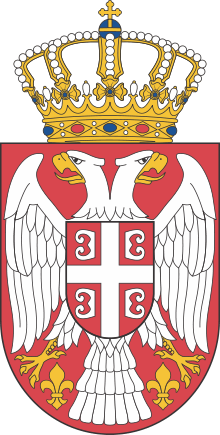Lužnica (region)
Lužnica (Serbian Cyrillic: Лужница) is a region in southeastern Serbia, comprising the Lužnica river basin. It includes parts of the Babušnica municipality and two villages in Bela Palanka (Pirot District).
Geography

The relief is mountainous, with dissecting valleys of a larger number of smaller streams. The process of erosion is developed at several places. The Lužnica basin has an altitude 470–520 m. The area is surrounded by the Suva Mountain in the west, Ruj Mountain in the south, and Vlaška Mountain in the northeast.
The average air temperature is 10–13 degrees celsius.[1]
Settlements
Although the region is not administratively marked, it is divided into two parts, Upper Lužnica (Gornja Lužnica) and Lower Lužnica (Donja Lužnica). Villages located in the region include Babušnica, Bogdanovac, Bratiševac, Brestov Dol, Vojnici, Gornje Krnjino, Gornji Striževac, Gorčinci, Grnčar, Dol, Donje Krnjino, Donji Striževac, Dučevac, Draginac, Izvor, Kaluđerevo, Kambelevci, Kijevac, Linovo, Ljuberađa, Modra Stena, Provaljenik, Radoševac, Resnik, Stol, Suračevo (in Babušnica), Bežište and Šljivovik (in Bela Palanka).
The 2011 census recorded the largest population decline in the country in this region.
Economy
The main economic activity in the region is farming, however, this micro-region is one of the underdeveloped areas of Serbia. Economic centers are Babušnica and Ljuberađa. Harsh living conditions and the economy in recent years has led to emigration to other parts of the country.
History
In 1841 Albanians had killed a priest and his son in Lužnica, after the Niš rebellion (1841).[2]
During the Serbo-Bulgarian War Serbian troops crossed the region.
During the Kingdom of Yugoslavia (1929–41), Lužnica was a district in the Morava Banovina.
The region was a site of military operations during World War II. In the Serbian puppet state (1941–44), Lužnica was a district in the Niš County.
Culture
Dialect
The Timok-Lužnica dialect is spoken in Lužnica. The Lužnica speech has some peculiarities, such as činiti instead of bojiti (an East Slavic innovation).[3]
Traditions
In Lužnica and Nišava at weddings, when the wedding guests (svatovi) go to fetch the bride, the čauš (master of ceremony, an entertainer) "begins to shout and brandish his sabre".[4]
It was recorded in 1958 that in Lužnica and Nišava, the day after the saint feast days of St. Demetrius, Michael the Archangel and St. Nicholas are holidays, where cattle are left to rest and work is suspended, as the cattle are feared to become sick (called žabica).[5]
Music
The traditional music in the region is the gusle and epic poetry. In 1910 it was recorded that the use of the gusle had decreased, compared to thirty years prior when "it was the favourite of the people".[6]
Dress
At the beginning of the 20th century, the women wore white headscarfs or silk scarves, while older women wore adorned red baize.[7]
Cuisine
A local specialty is the Lužnica vurda, a creamy cheese with paprika.
Monuments
The Lužnica church was built in 1873, and the oldest surviving log houses date to the same period.[8]
See also
References
- ↑ Boško Milovanović (2010). Klima Stare planine. Geografski institut „Jovan Cvijić“ SANU. pp. 12–. ISBN 978-86-80029-45-0.
- ↑ Srbija i Rusija: #. 1870. pp. 437–.
- ↑ Matica srpska (1969). Zbornik za filologiju i lingvistiku. 12. Novi Sad. p. 197.
- ↑ Слободан Зечевић (ed.). Гласник Етнографског музеја у Београду књ.35: Bulletin du Musée Ethnographique de Belgrade. Etnografski muzej u Beogradu. pp. 92–93.
- ↑ Srpski etnografski zbornik. 71-72. Državna štamparija. 1958. p. 177.
- ↑ Bulletin du Musée ethnographique de Beograd. 10. Muzej. 1935. p. 103.
- ↑ Петар Влаховић (ed.). Гласник Етнографског музеја у Београду књ. 58-59. Etnografski muzej u Beogradu. pp. 82–. GGKEY:ZN55KHXA7C8.
- ↑ Nadežda Pešić-Maksimović (1984). Spomeničke vrednosti seoskih centara u Srbiji. Republički zavod za zaštitu spomenika kulture. p. 137.
Sources
- Đura Zlatković-Milić (1967). Zla vremena: Monografija Lužnice (1876-1945). Prilozi za istoriju. Narodni univerzitet.
- Vladimir M. Nikolić (1910). Iz Lužnice i Nišave. Belgrade: Srpska kraljevska akademija.
